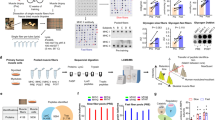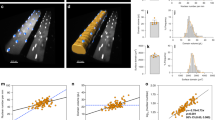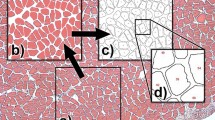Abstract
IN some animals, particularly amphibia and insects, normal function is ultimately restored in a limb which has been denervated. In the cockroach it has been shown that identified motoneurones reinnervate the same leg muscles as they did before the nerve was sectioned1,2. A possible explanation is that each muscle has specific molecules by which ingrowing nerves are able to recognise their appropriate destination. Recently, Denburg3, using sodium dodecyl sulphate(SDS)–polyacrylamide gel electrophoresis has shown that these cockroach muscles have distinct gel protein patterns which he suggests represent specific recognition molecules. Alternatively, the differences may arise because the motor neurones he considers are physiologically different types, ‘fast’ and ‘slow’. To test this interpretation we have examined a number of other cockroach muscles using Denburg's methods. All the muscles have patterns which may be grouped into the same categories as Denburg's even though they are innervated by different neurones. Where the innervation by ‘fast’ and ‘slow’ neurones is known the correspondence with our data is good. Furthermore, locust flight muscles with solely ‘fast’ innervation all have identical patterns. We conclude that gel electrophoresis patterns demonstrate a characteristic of the type of innervation rather than representing specific recognition molecules.
This is a preview of subscription content, access via your institution
Access options
Subscribe to this journal
Receive 51 print issues and online access
$199.00 per year
only $3.90 per issue
Buy this article
- Purchase on Springer Link
- Instant access to full article PDF
Prices may be subject to local taxes which are calculated during checkout
Similar content being viewed by others
References
Young, D. in Developmental Neurobiology of Arthropods (ed. Young, D.) 179–202 (Cambridge University Press, London, 1973).
Pearson, K. G. & Bradley, A. B. Brain Res. 47, 492–496 (1972).
Denburg, J. L. Nature 258, 535–537 (1975).
Fairbanks, G., Steck, T. L. & Wallach, D. F. H. Biochemistry 19, 2606–2617 (1971).
Carbonell, C. S. Smithson Misc. Collns 107, 1–23 (1947).
Pearson, K. G. & Iles, J. F. J. exp. Biol. 54, 215–232 (1971).
Pearson, K. G. & Bergman, S. J. J. exp. Biol. 50, 445–471 (1969).
Usherwood, P. N. R. J. Insect Physiol. 8, 31–52 (1962).
Guthrie, D. M. & Tindall, A. R. The Biology of the Cockroach (Edward Arnold, London, 1968).
Bentley, D. R. J. Insect Physiol. 16, 905–918 (1970).
Tyrer, N. M. & Altman, J. S. J. comp. Neural. 157, 117–137 (1974).
Burrows, M. J. comp. Physiol. 83, 165–178 (1973).
Author information
Authors and Affiliations
Rights and permissions
About this article
Cite this article
TYRER, N., JOHNSON, K. Does electrophoresis of cockroach muscle proteins detect recognition molecules?. Nature 268, 759–761 (1977). https://doi.org/10.1038/268759a0
Received:
Accepted:
Issue Date:
DOI: https://doi.org/10.1038/268759a0
Comments
By submitting a comment you agree to abide by our Terms and Community Guidelines. If you find something abusive or that does not comply with our terms or guidelines please flag it as inappropriate.



